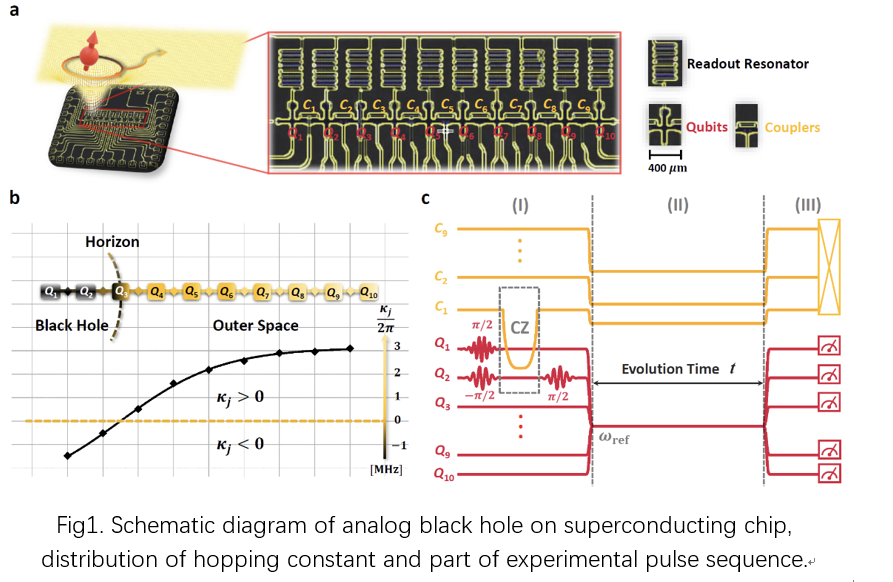Research Progress
Simulating the quantum effects of black holes on superconducting quantum chips
Black hole is a special object predicted by Einstein's General relativity. In recent years, the theoretical research,astronomical observation of black holes, the detection of gravitational wave generated by black hole mergers and other works all have been honored with the Nobel Prize. In the early 1970s, research by Hawking, Birkenstein, and others showed that black holes have thermodynamic properties: black holes have entropy and is proportional to their event horizon area; Black holes radiate particles outward in the form of thermal radiation, and their radiation temperature is proportional to their surface gravity; The mass, entropy and temperature of a black hole satisfy the first law of thermodynamics. The thermodynamics of black holes reveals the quantum effect of gravity. Therefore, it is generally believed that the black hole is a window to the theory of quantum gravity.
However, testing the quantum effects of black holes through experiments is an extremely challenging task, as these effects are very weak and difficult to observe. For example, the Hawking temperature of a black hole with the size of Solar mass is only 10-8K, which is far lower than the temperature of Cosmic microwave background radiation (≈ 3K). The lack of direct experimental verification is also a reason that the theoretical research of "gravitational quantization" is bogged down. In such a situation, people attempt to create an equivalent "curved spacetime" in the laboratory system and study the relative effects. This study is called "analog gravity". It was first proposed by William Unruh, who proposed the famous Unruh effect (an accelerated observer in a flat spacetime will see him in a heat bath) in 1981 [1] . Recently, an important progress has been made in the research of "analogy ". The researchers from Institute of Theoretical Physics CAS, Institute of Physics CAS and Tianjin University observed the Hawking radiation of "analog black hole" on the superconducting quantum chip and studied the influence of curved spacetime on quantum entanglement. Related work has been published in Nat Comm. 14, 3263 (2023) [2].
This work is inspired by the previous theoretical article [3]. It shows that, after discretization of spatial coordinates in Eddington Finkelstein coordinates, the 1+1-dimensional massless scalar field and fermionic field can be quantized, and equivalent to the XY model of which the hopping constant becomes site-dependent; The metric information of curved spacetime is encoded in the distribution function of hopping constant. However, it is a highly challenging to achieve such an XY model with a specific distribution of hopping constant in experiments. In the recently paper [2], this challenge was overcome. Using a one-dimensional array superconducting quantum chip with 10 qubits and 9 couplers, the researchers realized the 1+1-dimensional curved space-time background by precisely controlling the coupler so that the equivalent hopping constant between bits is distributed from negative to positive, and observed the propagation behavior of quasiparticle in the curved space-time background. The results show that there is always a certain probability that the quasiparticle inside the analog black hole will radiate through the event horizon, and its radiation probability satisfies the property of Hawking radiation. The researchers used “Quantum State Tomography” technology to reconstruct the density matrix of all bits outside the black hole, calculate the corresponding radiation probability, and confirm the existence of analog Hawking radiation. In addition, the researchers also prepared a Bell state inside the black hole and compared the entanglement dynamics in flat and curved spacetime backgrounds. This experimental study opens up a new path for simulating the quantum effects of curved spacetime and black holes in superconducting quantum chips.

This work was supported by the National Natural Science Foundation of China, the Ministry of Science and Technology, the Beijing Natural Science Foundation, and the Leading Special Project of the Chinese Academy of Sciences.
[1] W. G. Unruh, Experimental Black-Hole Evaporation?, Phys. Rev. Lett. 46, 1351 (1981).
[2] Y.-H. Shi, R.-Q. Yang, Z. Xiang, Z.-Y. Ge, H. Li, Y.-Y. Wang, K. Huang, Y. Tian, X. Song, D. Zheng, K. Xu, R.-G. Cai, H. Fan, Quantum simulation of Hawking radiation and curved spacetime with a superconducting on-chip black hole, Nat. Comm. 14, 3263 (2023).
[3] R.-Q. Yang, H. Liu, S. Zhu, L. Luo, and R.-G. Cai, Simulating quantum field theory in curved spacetime with quantum many-body systems, Phys. Rev. Research 2, 023107 (2020).
